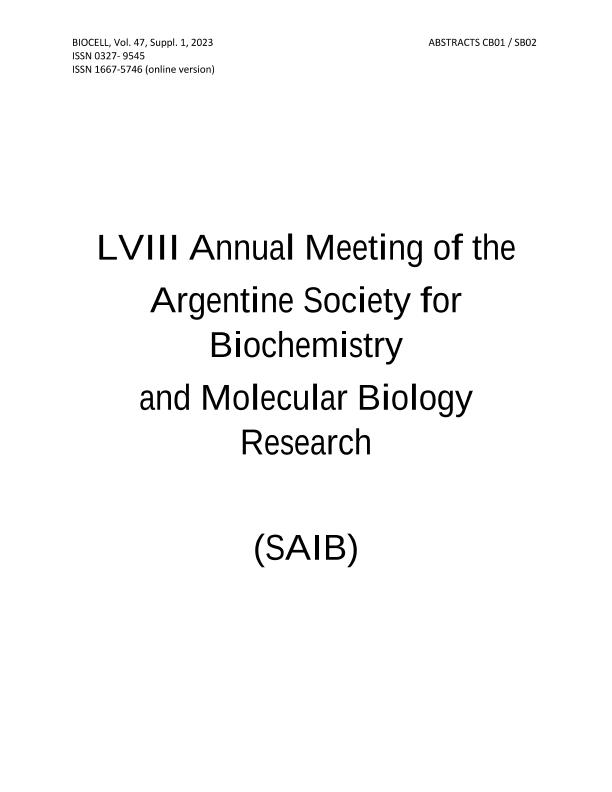Evento
Oxidative stress and lipolysis: new insights in fat metabolism
Funk, Melania Iara ; Maniscalchi, Athina del Valle; Benzi Juncos, Oriana Nicole
; Maniscalchi, Athina del Valle; Benzi Juncos, Oriana Nicole ; Alza, Natalia Paola
; Alza, Natalia Paola ; Conde, Melisa Ailén
; Conde, Melisa Ailén ; Salvador, Gabriela Alejandra
; Salvador, Gabriela Alejandra ; Uranga, Romina Maria
; Uranga, Romina Maria
 ; Maniscalchi, Athina del Valle; Benzi Juncos, Oriana Nicole
; Maniscalchi, Athina del Valle; Benzi Juncos, Oriana Nicole ; Alza, Natalia Paola
; Alza, Natalia Paola ; Conde, Melisa Ailén
; Conde, Melisa Ailén ; Salvador, Gabriela Alejandra
; Salvador, Gabriela Alejandra ; Uranga, Romina Maria
; Uranga, Romina Maria
Tipo del evento:
Reunión
Nombre del evento:
LVIII Reunión Anual de la Sociedad Argentina de Investigación en Bioquímica y Biología Molecular
Fecha del evento:
08/11/2022
Institución Organizadora:
Sociedad Argentina de Investigaciones en Bioquímica y Biología Molecular;
Título de la revista:
Biocell
Editorial:
Tech Science Press
ISSN:
0327-9545
e-ISSN:
1667-5746
Idioma:
Inglés
Clasificación temática:
Resumen
Prolonged oxidative stress (OS) directly affects fat metabolism, with implications in the onset of obesity, insulin resistance, and type 2 diabetes. Particularly in adipocytes, it is well known that OS participates in several mechanisms related with proliferation and differentiation. Our aim was to study the signaling events underlying lipolysis triggered by OS. For this purpose, we worked with different adipocyte in vitro cultures (differentiated 3T3L1 and mesenchymal stem cells) and with an in vivo model, all subjected to iron-induced OS. 3T3L1 adipocytes challenged with ferric ammonium citrate (FAC, 500-1000 µM) displayed augmented lipid peroxides and membrane permeability when compared with non-treated cells. The increase in OS markers observed in 3T3L1 adipocytes was coincident with a rise in glycerol release to the medium. These results were also corroborated in the in vivo model, where a decreased neutral lipid content in gonadal adipose tissue of iron-treated mice was observed. In addition, iron-treated animals presented a different architecture of gonadal fat characterized by cell shrinkage, decreased volume tissue, and fibrosis. Lipolysis in the white adipose tissue of humans and rodents is a step-wise process regulated by adipose triglyceride lipase (ATGL), hormone-sensitive lipase (HSL), and monoacylglycerol lipase. Exacerbated lipolysis was accompanied by the upregulation of βcatenin expression in 3T3L1 and in gonadal adipocytes. To ascertain the role of this signaling pathway in OS-induced lipolysis, we worked with adipocytes differentiated from primary mesenchymal stem cells with wild type expression or deletion of β-catenin gene. To this end, stem cells were isolated from outer ears of β-catenin fl/fl mice and after differentiation to adipocytes, gene deletion was induced with adenoviral Cre recombinase. The expression of the lipolytic enzymes, ATGL and HSL, was evaluated by qRT-PCR in wild type and β-catenin knock out (β-catenin KO) adipocytes exposed to vehicle or FAC. In wild type adipocytes, iron exposure increased ATGL and HSL mRNA levels, whereas lipolytic enzyme expression remained unchanged in β-catenin KO cells. Our results demonstrate that iron-induced OS is able to activate lipolysis through a mechanism involving the β-catenin pathway in fat cells.
Palabras clave:
oxidative stress
,
fat metabolism
Archivos asociados
Licencia
Identificadores
Colecciones
Eventos(INIBIBB)
Eventos de INST.DE INVEST.BIOQUIMICAS BAHIA BLANCA (I)
Eventos de INST.DE INVEST.BIOQUIMICAS BAHIA BLANCA (I)
Citación
Oxidative stress and lipolysis: new insights in fat metabolism; LVIII Reunión Anual de la Sociedad Argentina de Investigación en Bioquímica y Biología Molecular; Mendoza; Argentina; 2022; 173-173
Compartir



